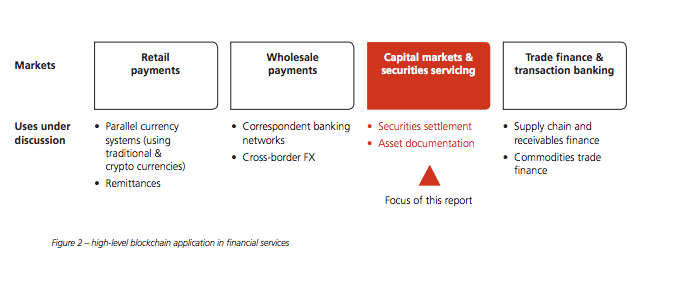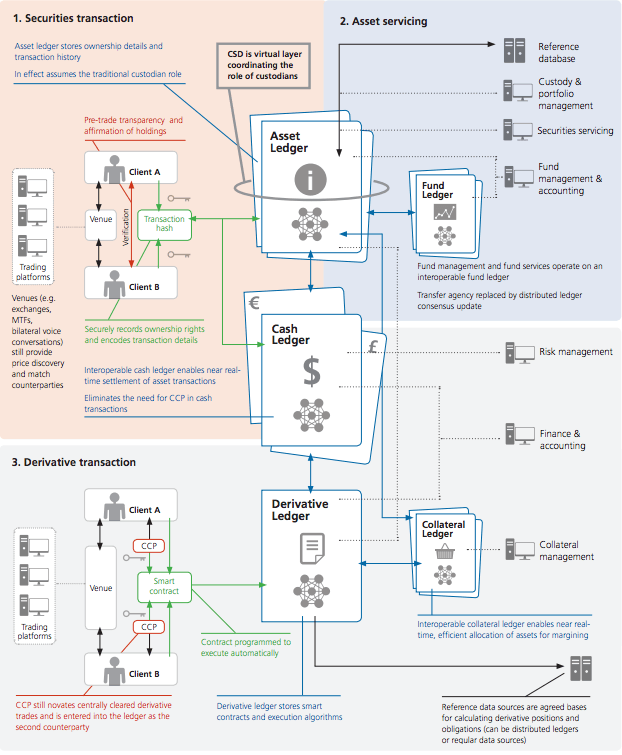
How Blockchain Will Impact and Create a Neurological Disruption of the Capital Markets
Introduction: Major Neurological Disruption of the Capital Markets
As Blockchain becomes bigger one of the critical elements is that this radical technology being based in digital ledger that made the first big digital currency possible – Bitcoin – is critical and a major disruption to be considered for the capital markets. So the big billion dollars question is how blockchain can be applied to capital markets?
Blockchain is now a neurological disruption to the global technology infrastructure. It is not a trend or hype is an advent of a series of revolutions that integrate distributed ledgers technologies that started with the advent of the internet, big data, IOT (internet of every-thing), and AI.
Although there is somehow a critical utopian view and now over hype understanding (or lack of it) about blockchain, there is no doubt that this is a major thing for capital markets – a neurological shift. Blockchain and associated innovations are taking over the financial industry as a whole, and over the global technology DNA, and we are going to see much more happening next months and years as we digitalised most of the world infrastructures but still co-exist with various obsolete systems and models. This is particular relevant in trading and investing and capital markets.
Some important things to consider looking at blockchain and financial – capital markets:
- In the present landscape of the Fintech driven financial world there will be major challenging disruptions developed outside of the core capital markets ecosystem and blockchain is the central DNA where everything is happening.
- In the next months, years there will be some significant changes and disruptions driven by Blockchain and associated technologies and solutions – AI and big data driven.
- The Collaborative efforts, both technological, infrastructure and system wise are shifting the existing value chain of capital markets to blockchain, and are changing infrastructures.
- Most of the overall operations of the capital markets industry will be affected special the legal, compliance systems, namely with the advent of smart contracts tech models and its development and maturity.
- The present set up of payments and currencies was already changed irreversibly with the advent of bitcoin and now its foundation technology – blockchain. It will start affecting all trading and investing operations in next years.
- Although much of the present changes and efforts have started, with potentially massive benefits, it will take years to overhaul core parts of the system and this will bring other challenges regarding centralised and decentralised versions of blockchain.
- There will be necessary a clear mandate of global and local policy supervisors, central banks, governments that need to advise and direct the industry to introduce new market foundations and infrastructure, so that costs are reduced or that operational or systemic risk are lessened.
- The capital markets relation with storage, wealth creation and management is and will be profoundly changed with the advent of blockchain.
- The different and many middle men in the capital markets industry will be reduced as blockchain, big data and AI driven solutions will scale and minimise all teh present layers of data and operations.
Different Velocities, Trust, Capital Markets, AI and Blockchain
There are various critical thing for financial industry and the capital markets. One important thing, probably the most important thing, is trust and continuity in markets. Money has been evolving around history and now is changing faster than ever. Markets are sensitive and feel everything around them. From macro changes in the economy to non far payrolls all the capital market ecosystem is now run by complex algorithms and increasingly AI. The problem is that the systems are dual and in parallel with this we have old systems and even manual processes that double and create a double matrix world – tale of various cities within the capital markets ecosystem.
One critical area for the survival and growth of capital markets is the storing and agreeing data-sets of financial data, financial obligations, and respective ownership forms the basic core to capital markets operations. The problem is that the current capital markets methods are highly complex, utilise fragmented and sensitive IT infrastructure, and most of its present data architectures suffer from a lack of common standards. Moreover they can be easily hacked and manipulated.
This present situation creates a continual need to reconcile different sources of data with massive systems and the process duplication, leading to high costs and protracted time to execute tasks and legal risks and trust issues. So the innovation that is arousing from blockchain driven distributed ledger tech solutions is major in the sense that can be a way to structure further the capital market needs and create a solid solution ecosystem.
With the advent of blockchain the world of capital markets can somehow standardise different systems and interrelate it in a better more efficient way. Like this the present double standard record of capital market security would be improved on a flat accounting basis – that is, with multiple levels of beneficial ownership in a single ledger.
As the most advanced banks, asset management, hedge funds use the most advanced algorithm trading solutions, driven by most advanced AI for managing 80% or over this of the world world financial and trading operations we have an issue in terms of infrastructure and operations of the remaining capital markets industry that operates at various velocities. This creates many issues like manipulation of markets and financial data and storage issues.
Blockchain offers makes standard operations for continuous data normalisation
The advent of the financial ledgers tech that blockchain driven tech offers makes standard operations for continuous data normalisation, reconcile obsolete internal systems, or agree exposures and obligations. Blockchain driven tech have the structure capacity to create a standardised set of processes and services, shared reference data, standardised processing capabilities (such as reconciliations), near real-time data and improved understanding of counterpart worthiness.
For privileged participants such as regulators, Blockchain solutions in particular can create a transparent data on holdings, among many other improvements.
Bellow an infographic example of different ways to look at blockchain solutions in the various areas of financial transactions:

The advent of blockchain to capital markets can create a stronger global system to normalise systems, processes and data storage, according to a great report by Oliver Wyman: Blockchain in Capital Markets The Prize and the Journey February 2016. In this report Oliver Wyman and Euroclear come out with an overview of how blockchain can influence and disrupt capital markets. Here one excerpt that better synthetises their views:
1. Securities transaction: Client A and Client B are matched on an execution venue, and automatically verify that the other has the means to complete the transaction. (For example, Client A demonstrably owns the security on the asset ledger, and Client B demonstrably owns cash on the cash ledger). Client A and Client B jointly ‘sign’ the transaction by applying their private keys to unlock their asset or cash, and then by transferring ownership to the recipient via their public key. The signed transaction is broadcast to the distributed ledger to be validated and recorded in the next update, along with a simultaneous update to a cash ledger.
2. Asset servicing For new issues, assets are issued directly onto the asset ledger. In fact, securities themselves could be unbundled so that the individual cash flows, and the rights they encapsulate, could be transferred separately.
3. Derivative transaction: The utopian setup for derivatives represents the biggest change. In the first instance, unbundled securities could enable new approaches to financial engineering, enabling specialists to construct bespoke instruments consisting of individual cash flows that meet precise needs in terms of timing and credit risk. These instruments could be financed by issuers selling their own instruments that match the cash flows they expect to achieve, in essence creating swaps without the need for balance sheet intermediation.

Summary:
Blockchain is bringing a massive revolution for the financial markets not seen in centuries. By creating a standardise system and processes it can create a much more effective system, improve credibility, trust and transparency to both storagre of financial data and flows. Also make a sound bridge between the present two world of ultra advanced tech trading and investing players with the traditional storage, regulation and back office players.
Blockchain can as well and will remove the middleman partly or entirely and create a scalable ecosystem once the technology is advanced enough to sustain a global flow of data and reporting.
As a powerful report published by the SWIFT Institute argued recently the Blockchain technology does not entirely remove the need for third parties, even if it demands a “substantial re-engineering of business processes across multiple securities market firms.” This is innvitable special for financial operators and regulators but they will be also disrupted with this advent that is an evolution of the internet and particular associated with big data, social media data and AI.
Of course there are various challenge for the blockchain technological driven solutions in capital markets and in the world in general. One of them is that there are two main types of blockchains:
- Public blockchain – everyone can read or write data.
- Private blockchain – in which all the participants are known and trusted.
These two systems have substantial differences and of course can create a monopoly of organisations that can control the entire global capital markets industry if there is no solid regulation in place.
Another thing to take into consideration is that the present capital markets systems bases itself in an amount of real money, which is located in capital markets, and that is not real any more as with quantitative easing the real money in the world versus debt is now a serious critical issue for the global world economy and no technology can solve that only policy makers and global leaders.
So blockchain is already impacting capital markets but the reality, politic circumstances and the complex macro and micro economics are much more complex than this radical shift neurological innovation technology.
Dinis Guarda is an author, academic, influencer, serial entrepreneur and leader in 4IR, AI, Fintech, digital transformation and Blockchain. With over two decades of experience in international business, C level positions and digital transformation, Dinis has worked with new tech, cryptocurrencies, drive ICOs, regulation, compliance, legal international processes, and has created a bank, and been involved in the inception of some of the top 100 digital currencies.
Dinis has created various companies such as Ztudium tech platform a digital and blockchain startup that created the software Blockimpact (sold to Glance Technologies Inc) and founder and publisher of intelligenthq.com, hedgethink.com, fashionabc.org and tradersdna.com. Dinis is also the co-founder of techabc and citiesabc, a digital transformation platform to empower, guide and index cities through 4IR based technologies like blockchain, AI, IoT, etc.
He has been working with the likes of UN / UNITAR, UNESCO, European Space Agency, Davos WEF, Philips, Saxo Bank, Mastercard, Barclays and governments all over the world.
He has been a guest lecturer at Copenhagen Business School, Group INSEEC/Monaco University, where he coordinates executive Masters and MBAs.
As an author, Dinis Guarda published the book 4IR: AI, Blockchain, FinTech, IoT, Reinventing a Nation in 2019. His upcoming book, titled 4IR Magna Carta Cities ABC: A tech AI blockchain 4IR Smart Cities Data Research Charter of Liberties for our humanity is due to be published in 2020.
He is ranked as one of the most influential people in Blockchain in the world by Right Relevance as well as being listed in Cointelegraph’s Top People In Blockchain and Rise Global’s The Artificial Intelligence Power 100. He was also listed as one of the 100 B2B Thought Leaders and Influencers to Follow in 2020 by Thinkers360.









